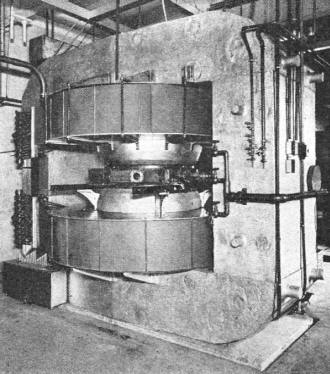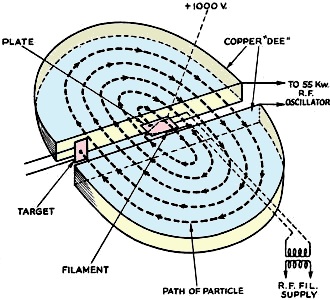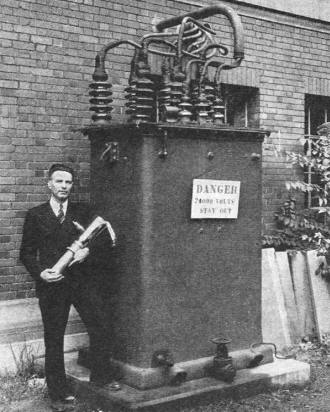Radio and Atom Busting |
|
Connecting a diode backwards across a solenoid coil to shunt potentially damaging current and/or voltages when the supply is turned off is a common trick for saving connected circuitry. Depending on the magnitude of the magnetic field and how quickly the field collapses, some really high voltages can be produced. In fact, the ignition coil and point (now solid state) system in exploits exactly that principle to turn the 12 volts from your car battery into 20-40 kV for firing the spark plugs. Engineers that designed this early cyclotron had limited options for what to use given the state of the art in the early 1940s, and chose to keep the generator permanently connected to the coil (no switch) so that if the controller failed, the coil's energy 15 kgauss magnetic field) would flow back into the generator. That, of course, is the equivalent of refrigerator magnet compared to magnetic fields set up by the Large Hadron Collider (LHC) in the EU in search of the Higgs boson. Radio and Atom Busting - A Glimpse at the Cyclotron By J. S. V. Allen,* W8UNS Imagine the ecstasies of an amateur who had nursed a 200-watt transmitter up to 300 watts, and then suddenly had the opportunity of playing with an 80,000-watt rig that loafs along at 40 kilowatts input! Therein lies a story. A cyclotron is a tremendous affair because it is necessary to build up terrific particle velocities to disintegrate atoms. This 42-inch (chamber diameter) cyclotron at the Ohio State University was constructed and is operated through the aid of Julius F. Stone, the Ohio State University Development Fund, and WPA aid. One of the more recent scientific developments employing radio frequency power is the cyclotron or "atom-smasher," which threatens to revolutionize our lives some time in the future by unleashing almost limitless sources of atomic energy. A brief description of this scientific wonder and the part played by high-frequency radio may be of interest to the radio amateur. Also, some of the humorous and unusual experiences and observations of an enthusiastic ham may be interesting to others in the realm of Hamdom. The 100-ton cyclotron recently completed at the Ohio State University, at a cost of $60,000, is the product of over two years of unceasing toil by Dr. M. L. Pool1 and his associates. Eighty tons of iron went into the construction of the magnet core, which was wound with more than nine miles of 7/16-inch copper tubing. Through this tubing a current of 300 amperes may be passed, if at the same time water is circulated through the tubing for cooling purposes. Automatic switches have been installed to stop the current if the water should cease to flow, thus preventing the high current from burning up the large magnet coils. It requires several minutes for a 50 kw. motor-generator to build up a current of 300 amperes, and during this time the magnet creaks from magnetic forces being set up within the coils. If the circuit should accidentally be opened, the destructive forces would be considerable because of the enormous amount of energy stored within the large magnetic field (15,000 gauss over 1400 square inches). For this reason the magnet and the generator are permanently connected. If the motor of the motor-generator (M.-G.) set is turned off, the energy flows from the magnet into the generator and reverses the set. Hence, the field in the generator is reduced first, and then the M.-G. set is shut down. How the Cyclotron Works The construction and operation of the cyclotron, briefly stated, are as follows: There is a large cylindrical vacuum chamber, 42 inches in diameter and 8 inches high, between the magnet poles. Within this chamber are two "dees," so-called because they ate shaped like the letter D. These two copper dees are electrodes supported within the chamber by insulators and connected to the radio frequency power oscillator. Near the center of the chamber is a tungsten filament, which must be heated by radio frequency current because the interaction between ordinary alternating or direct current and the 15,000-gauss magnetic field would bring destructive forces to bear upon the filament. Hence, an 806-833 "transmitter" (650 watts), operating on 200 kc., is used to light the filament with r.f. Above the filament is a plate, at 1000 volts positive potential to draw a beam of electrons from the filament. The beam passes vertically along the axis, ionizing the low-pressure hydrogen within the chamber. The protons, or ionized hydrogen nuclei, have a positive charge, and are pushed and pulled around and around between the two hollow dee-shaped electrodes 10.5 million times per second as the polarity of the dees oscillates. When a state of resonance exists, the positive hydrogen ion arrives between the dees in time to be attracted by the negative charge on the one dee and repelled by the positive charge on the other dee. But in moving, the proton must pass through the strong magnetic field which turns the ion in a semicircle. Each time the ion runs the gauntlet between the dees it receives an electrical kick in the pants, figuratively speaking, of about 40,000 volts. In this way the speed of the ion is increased to about 6,000 miles per second before it crashes into the target at the outer edge of the chamber. With higher velocities a new difficulty is encountered - relativity. The ions become heavier because of their tremendous velocities, and hence cannot be accelerated as easily. The path of the ion from the center to the target is a series of about 125 semicircles with increasing radii, the increase taking place each time the ion is accelerated between the dees. The R.F. Oscillator The most interesting part of the cyclotron to the ham is the 80-kw. power oscillator used to drive the ions back and forth between the dees. This shielded radio transmitter employs a pair of 859 tubes. Don't look in your Handbook for the characteristics of this tube for it exceeds the maximum amateur input by about 4000% (2000% in California)! Each tube is capable of handling more than 40 kw. at 10.5 megacycles, the frequency used. With an input of 50 kw. the plate dissipation is 20 kw., requiring a flow of from 8 to 15 gallons of water per minute. The filament current is 70 amperes and the voltage across the two units of the filament is 22. The tube is two feet in height - a real bottle! With an input of 40 kw., perhaps 2 kw. reach the water-cooled target where the atoms are cracked, and is dissipated over an area approximately 0.05 square inch. Try that on your final amplifier tube! The target becomes white hot during some bombardments. While cyclotrons and many other devices utilizing the electronic art which has developed as a result of radio research are not, strictly speaking, "another part of the family," some of them are not very distant cousins. This article is presented with the thought that the ordinary amateur is enough interested in general science to want to know what the more interesting developments are in allied fields. If the gang wants, we'll try to have more articles of this nature from time to time. The power oscillator is housed in a large copper enclosure several feet from the cyclotron. The r.f, power is transferred to the chamber of the atom-smasher by means of a transmission line which includes a quarter-wavelength section. The shorting bar on this line is adjustable, permitting rough tuning. The fine tuning is accomplished by a man-sized variable condenser - a 13 square-foot vane hinged over the transmission line and adjusted by means of a motor. This whole Lecher system is made of 5-inch copper tubing and must be water-cooled for good stability. The voltage multiplication obtained by making the transmission line shorter than a quarter-wavelength is about 100. If one stands close to the transmission line his ears become uncomfortably warm from induced r.f.; there is some evidence that sinus trouble has been cured while working in the r.f. field of the transmission line. The frequency of the power-oscillator must be maintained within a few kilocycles of the resonance frequency for a certain strength of magnetic field, otherwise the ions will fall out of step and will arrive at the gap between the dees at the wrong time to receive the greatest acceleration. The operator can control the frequency by varying the capacity through the tuning vane above the transmission line. Or an automatic gadget called a discriminator can be used. This automaton2 consists of an electron-coupled oscillator, amplifying circuits and a bridge circuit. Its oscillator is tuned to a frequency 5,000 kilocycles below the frequency of the power oscillator, giving a heterodyne signal of 5,000 kc., which is applied to a bridge circuit balanced at 5,000 kc. Any variation in the frequency of the power oscillator resulting from load reactance changes caused by heating in the power circuits causes the heterodyne beat to change and the bridge to become unbalanced proportionately. The unbalanced voltage controls the motor which varies the position of the tuning vane, and the frequency of the large oscillator is thus restored to resonance. Occasionally the power oscillator becomes unstable and a heavy r.f. arc jumps across the grid line used to tune the grid circuit. At these times the discriminator is thrown into a state of nervous disorder. Sometimes it will adjust the tuning capacity first in one direction, then in the other, very rapidly. But under normal conditions this gadget operates very well. When the grid circuit breaks down with a thunderous arc, the discharge sometimes drills a very fine hole through the centers of the nine-inch insulators, or an insulator may be shattered by the arc. The operator is always alert for such emergencies, and quickly turns off the power to prevent more damage. One rainy day the 100 kva., 20,000-volt, three-phase power transformer3 arced with a great flash and noise. Later the same day the author was operating the cyclotron and worrying about another transformer flash-over when a 150-watt lamp over his head burned out with a bright flash. Nervous prostration set in, but not before he had turned off all the power in a split second! Warning - Leave Watches Outside! W8UNS alongside the 100-kva. power transformer. The bottle is an 859, rated at 40 kw. input. Two of them are used in the cyclotron oscillator. Many interesting things happen around a cyclotron which are not duplicated elsewhere. One source of several interesting tales is the strong magnetic field. If one approaches the large magnet with iron tools in his pockets he can feel them move in strange ways under the influence of the field. An eight-inch wrench which was passed carefully from one man to another was drawn with terrific force to the magnet, and it took two men to pull it off the magnet pole. An iron box was once carried too close to the cyclotron, with the result that the magnet had to be turned off before the box could be extricated. Many people visit the cyclotron, and are warned before they enter the laboratory that their watches will be magnetized if carried near the magnet. In spite of this warning one lady carried her watch into the cyclotron room in her purse and later asked if it was not all right, since she had not removed it from her purse while near the large magnet! She did not realize that imitation leather is a very poor magnetic shield. A demagnetizing coil such as a jeweler uses is kept in an adjacent laboratory for such cases. One day a visiting monkey from a near-by laboratory was scampering all over the cyclotron, with workmen in hot pursuit. An ether gun and other devices were used in trying to catch the unwelcome visitor but the cyclotron itself finally accomplished this feat. When the monkey tried to run through the belt of a small vacuum pump its foot was caught, and the belt held it until a keeper captured the monkey. But atom-smashing is not all monkey business, as the following paragraphs about the products of the cyclotron will demonstrate. The material placed in the cyclotron is bombarded with protons, neutrons, deuterons, or alpha particles, with the result that minute quantities of the material are activated, after which they radiate much the same as radium does. In fact certain radioactive elements are used instead of radium in treating cancer, leukemia, and other diseases. These radioactive substances can be used as tracers within the human body, as shown by the experiment in which a person is fed some radioactive material which enters the blood and reaches the fingers within a very few minutes. The radioactivity can be detected in the finger tips by holding them near a Geiger-Muller counter which clicks each time a particle from an exploding atom pierces the counter tube. These radioactive substances have been called the greatest contribution to medical research since the discovery of the microscope. Atomic power is perhaps a possibility in the not too distant future, for uranium 235 can already be cracked and made to yield enormous amounts of energy, relatively speaking. The difficulty lies in the scarcity of uranium 235. If such power does become available in considerable amounts men will no longer fight for oil fields and similar natural resources. Energy will be so easily obtained, and in such concentrated forms, that it will revolutionize much of our living. If men still choose to have wars they will be fought more fiercely, for modern wars are fought with such materials as gasoline and high explosives, which are very concentrated forms of energy. Atomic energy will be 5000 times more concentrated than gasoline. * Bethany College, Bethany, W. Va. 1 "The Ohio State University Cyclotron," Alpheus W. Smith and M. L. Pool, Physical Review, Feb. 15, 1940. 2 "An Automatic Frequency Control for Cyclotron R.F. Power Supply," R. B. Jacques, Physical Review, June 1, 1941. 3 Donated by Radio Station WJR through Professor W. L. Everitt.
Posted November 16, 2022 |
|



